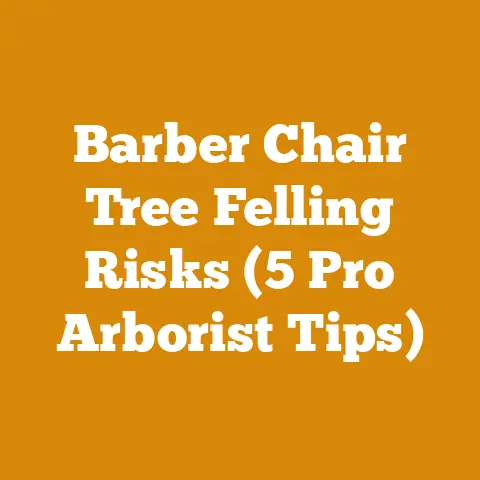Stihl 291 Troubleshooting Guide (5 Pro Chainsaw Fixes)
In the world of wood processing and firewood preparation, the roar of a chainsaw is often the first sound of progress.
But even the most reliable workhorses, like the Stihl MS 291, can sometimes stumble.
As someone who’s spent countless hours felling trees and processing wood, I’ve learned that understanding common issues and knowing how to troubleshoot them is just as important as mastering the cut.
The Stihl MS 291 is a popular choice for both homeowners and professionals due to its power and dependability.
However, like any mechanical tool, it can experience problems that prevent it from performing optimally.
This guide will address five common issues encountered with the Stihl MS 291 chainsaw and provide practical fixes to get you back to work safely and efficiently.
Stihl 291 Troubleshooting Guide (5 Pro Chainsaw Fixes)
1. Chainsaw Won’t Start
A chainsaw that refuses to start is a frustrating problem.
I remember one particularly cold morning when my MS 291 simply wouldn’t fire up.
After a few minutes of frantic pulling, I took a deep breath and started systematically troubleshooting the issue.
It turned out to be a simple fix, but the experience taught me the importance of methodical diagnosis.
Possible Causes and Solutions:
Fuel Issues:
- Old or Contaminated Fuel: This is the most common culprit.
Chainsaws require a specific fuel mixture (usually 50:1).
Old fuel can degrade, and contaminants can clog the fuel system.- Fix: Drain the fuel tank completely.
Prepare a fresh fuel mixture using high-quality two-stroke oil and gasoline with an octane rating of 89 or higher.
I prefer using Stihl’s own premixed fuel for convenience and peace of mind.
- Fix: Drain the fuel tank completely.
- Clogged Fuel Filter: The fuel filter prevents debris from entering the carburetor.
A clogged filter restricts fuel flow.- Fix: Locate the fuel filter inside the fuel tank (usually attached to the fuel line).
Use a hook tool to pull it out.
Inspect the filter for debris.
If it’s dirty, replace it with a new one.
Fuel filters are relatively inexpensive, so it’s a good idea to keep a few spares on hand.
- Fix: Locate the fuel filter inside the fuel tank (usually attached to the fuel line).
- Blocked Fuel Line: The fuel line carries fuel from the tank to the carburetor.
Cracks, kinks, or blockages can disrupt fuel flow.- Fix: Inspect the fuel line for any visible damage.
If the line is cracked or kinked, replace it.
You can also try blowing compressed air through the line to clear any blockages.
If the blockage persists, replace the fuel line.
- Fix: Inspect the fuel line for any visible damage.
-
Spark Issues:
-
Faulty Spark Plug: The spark plug ignites the fuel-air mixture in the cylinder.
A fouled or damaged spark plug can prevent the engine from starting.- Fix: Remove the spark plug using a spark plug wrench.
Inspect the electrode for wear, carbon buildup, or cracks.
Clean the electrode with a wire brush or replace the spark plug altogether.
The spark plug gap should be 0.5 mm (0.020 inches).
Use a feeler gauge to ensure the correct gap.
- Fix: Remove the spark plug using a spark plug wrench.
- Weak Ignition Coil: The ignition coil generates the high voltage needed to create a spark.
A weak or faulty coil may not produce enough spark to ignite the fuel.- Fix: This requires more advanced testing with a multimeter.
Check the coil’s primary and secondary resistance according to the Stihl MS 291 service manual.
If the readings are outside the specified range, replace the ignition coil.
I recommend having a qualified technician perform this test.
- Fix: This requires more advanced testing with a multimeter.
- Short Circuit: A short circuit in the wiring can prevent the ignition system from functioning properly.
- Fix: Inspect the wiring harness for any frayed or damaged wires.
Repair or replace any damaged wiring.
- Fix: Inspect the wiring harness for any frayed or damaged wires.
-
Air Intake Issues:
-
Dirty Air Filter: A clogged air filter restricts airflow to the engine, causing it to run lean and potentially preventing it from starting.
- Fix: Remove the air filter and inspect it for dirt and debris.
Clean the filter with warm soapy water or compressed air.
Allow the filter to dry completely before reinstalling it.
If the filter is heavily soiled or damaged, replace it.
- Fix: Remove the air filter and inspect it for dirt and debris.
- Choke Position: The choke enriches the fuel mixture for cold starts.
If the choke is not set correctly, the engine may not start.- Fix: For a cold start, engage the choke completely.
After a few pulls, disengage the choke to the half-choke position.
Once the engine starts, gradually disengage the choke completely.
- Fix: For a cold start, engage the choke completely.
- Flooding: Excessive fuel in the cylinder can prevent the engine from starting.
- Fix: Remove the spark plug and pull the starter cord several times to clear excess fuel from the cylinder.
Allow the cylinder to air out for a few minutes before reinstalling the spark plug.
- Old or Contaminated Fuel: This is the most common culprit.
Personal Tip: I always carry a small toolkit with me when I’m working in the woods.
This kit includes a spark plug wrench, a spare spark plug, a fuel filter, and a small container of premixed fuel.
This has saved me countless hours of downtime over the years.
Takeaway: A systematic approach to troubleshooting is crucial.
Start with the simplest potential causes (fuel, spark, air) and work your way towards more complex issues.
2. Chainsaw Starts but Dies Immediately
A chainsaw that starts briefly but then dies can be just as frustrating as one that won’t start at all.
This often indicates a problem with fuel delivery or engine regulation.
I once spent an entire afternoon chasing this issue, only to discover a tiny crack in the fuel line that was causing intermittent fuel starvation.
Possible Causes and Solutions:
Carburetor Issues:
- Dirty Carburetor: The carburetor mixes air and fuel to create the proper mixture for combustion.
A dirty carburetor can disrupt this process.- Fix: Clean the carburetor using carburetor cleaner.
Disassemble the carburetor carefully, taking note of the location of all parts.
Spray carburetor cleaner through all the jets and passages.
Reassemble the carburetor and reinstall it on the chainsaw.
- Fix: Clean the carburetor using carburetor cleaner.
- Carburetor Adjustment: The carburetor has adjustment screws that control the air-fuel mixture.
Incorrect adjustments can cause the engine to stall.- Fix: Refer to the Stihl MS 291 service manual for the correct carburetor adjustment procedure.
The “L” screw controls the low-speed mixture, and the “H” screw controls the high-speed mixture.
Adjust the screws in small increments, listening to the engine’s response.
The engine should idle smoothly without stalling and accelerate cleanly without hesitation.
- Fix: Refer to the Stihl MS 291 service manual for the correct carburetor adjustment procedure.
-
Fuel Delivery Issues:
-
Vapor Lock: Vapor lock occurs when fuel vaporizes in the fuel line, preventing fuel from reaching the carburetor.
- Fix: Ensure that the fuel tank is properly vented.
Check the fuel line for any kinks or obstructions.
Allow the engine to cool down before attempting to restart it.
- Fix: Ensure that the fuel tank is properly vented.
- Fuel Tank Vent Clogged: The fuel tank vent allows air to enter the tank, preventing a vacuum from forming and restricting fuel flow.
- Fix: Locate the fuel tank vent (usually on the top of the tank).
Clean the vent with compressed air or a small wire.
- Fix: Locate the fuel tank vent (usually on the top of the tank).
-
Ignition Issues:
-
Intermittent Ignition Coil Failure: The ignition coil may be failing intermittently, causing the engine to stall after a short period of operation.
- Fix: Test the ignition coil with a multimeter while the engine is running.
Monitor the coil’s output voltage.
If the voltage drops or fluctuates erratically, replace the ignition coil.
- Fix: Test the ignition coil with a multimeter while the engine is running.
-
Exhaust Issues:
-
Clogged Spark Arrestor Screen: The spark arrestor screen prevents sparks from escaping the exhaust system.
A clogged screen can restrict exhaust flow, causing the engine to stall.- Fix: Remove the spark arrestor screen from the muffler.
Clean the screen with a wire brush.
If the screen is heavily clogged or damaged, replace it.
- Fix: Remove the spark arrestor screen from the muffler.
- Dirty Carburetor: The carburetor mixes air and fuel to create the proper mixture for combustion.
Personal Tip: When cleaning a carburetor, I always take pictures of each step of the disassembly process.
This helps me to remember the correct order of reassembly.
I also use a parts tray to keep track of all the small components.
Takeaway: Carburetor and fuel delivery issues are the most likely causes of this problem.
Pay close attention to the condition of the fuel lines, fuel filter, and carburetor components.
3. Chainsaw Runs Poorly (Low Power, Hesitation)
A chainsaw that lacks power or hesitates during cutting can make even simple tasks difficult.
This often indicates an issue with the air-fuel mixture, carburetor, or engine compression.
I remember one time when my MS 291 was struggling to cut through a seasoned oak log.
After checking the usual suspects (fuel, spark, air filter), I discovered that the carburetor was severely out of adjustment.
Possible Causes and Solutions:
Carburetor Issues:
- Incorrect Carburetor Adjustment: As mentioned earlier, incorrect carburetor adjustments can significantly impact engine performance.
- Fix: Fine-tune the carburetor adjustments according to the Stihl MS 291 service manual.
Pay close attention to the engine’s response to changes in the “L” and “H” screw settings.
- Fix: Fine-tune the carburetor adjustments according to the Stihl MS 291 service manual.
- Partially Clogged Carburetor Jets: Even a partially clogged jet can disrupt the air-fuel mixture and reduce engine power.
- Fix: Clean the carburetor thoroughly, paying particular attention to the jets.
Use a small wire or needle to clear any blockages.
- Fix: Clean the carburetor thoroughly, paying particular attention to the jets.
-
Air Intake Issues:
-
Dirty Air Filter: A dirty air filter restricts airflow, causing the engine to run lean and lose power.
- Fix: Clean or replace the air filter.
- Air Leaks: Air leaks in the intake system can disrupt the air-fuel mixture and cause the engine to run poorly.
- Fix: Inspect the intake manifold, carburetor mounting flange, and cylinder base for any signs of leaks.
Use carburetor cleaner to spray around these areas while the engine is running.
If the engine speed changes when you spray a particular area, it indicates an air leak.
Replace any damaged gaskets or seals.
- Fix: Inspect the intake manifold, carburetor mounting flange, and cylinder base for any signs of leaks.
-
Fuel Issues:
-
Incorrect Fuel Mixture: Using the wrong fuel mixture can cause the engine to run poorly and potentially damage it.
- Fix: Ensure that you are using the correct fuel mixture (usually 50:1).
Use high-quality two-stroke oil and gasoline with an octane rating of 89 or higher.
- Fix: Ensure that you are using the correct fuel mixture (usually 50:1).
- Water in Fuel: Water in the fuel can cause the engine to hesitate and lose power.
- Fix: Drain the fuel tank and carburetor completely.
Refill the tank with fresh fuel.
- Fix: Drain the fuel tank and carburetor completely.
-
Engine Compression Issues:
-
Worn Piston Rings: Worn piston rings can reduce engine compression, leading to a loss of power.
- Fix: This requires a compression test.
Use a compression tester to measure the cylinder pressure.
If the pressure is below the specified range, the piston rings may be worn and need to be replaced.
This is a more complex repair that may require professional assistance.
- Fix: This requires a compression test.
- Damaged Cylinder: A damaged cylinder can also reduce engine compression.
- Fix: Inspect the cylinder for any scoring or damage.
If the cylinder is damaged, it may need to be replaced.
This is a major repair that typically requires professional assistance.
- Fix: Inspect the cylinder for any scoring or damage.
- Incorrect Carburetor Adjustment: As mentioned earlier, incorrect carburetor adjustments can significantly impact engine performance.
Personal Tip: I always check the spark arrestor screen when troubleshooting engine performance issues.
A clogged screen can significantly reduce engine power.
Takeaway: A combination of factors can contribute to poor engine performance.
Start by checking the simplest potential causes (air filter, fuel mixture) and work your way towards more complex issues (carburetor adjustment, engine compression).
4. Chain Not Oiling Properly
Proper chain lubrication is essential for smooth cutting and preventing premature wear of the chain and bar.
A chain that is not oiling properly can quickly overheat and become damaged.
I once ruined a perfectly good chainsaw chain because I neglected to check the oiler.
The chain overheated and stretched, rendering it useless.
Possible Causes and Solutions:
Oil Tank Issues:
- Empty Oil Tank: This is the most obvious cause.
- Fix: Fill the oil tank with chain oil.
I recommend using Stihl’s own chain oil for optimal performance.
- Fix: Fill the oil tank with chain oil.
- Clogged Oil Filter: The oil filter prevents debris from entering the oil pump.
A clogged filter restricts oil flow.- Fix: Locate the oil filter inside the oil tank (usually attached to the oil line).
Use a hook tool to pull it out.
Inspect the filter for debris.
If it’s dirty, replace it with a new one.
- Fix: Locate the oil filter inside the oil tank (usually attached to the oil line).
- Oil Tank Vent Clogged: The oil tank vent allows air to enter the tank, preventing a vacuum from forming and restricting oil flow.
- Fix: Locate the oil tank vent (usually on the top of the tank).
Clean the vent with compressed air or a small wire.
- Fix: Locate the oil tank vent (usually on the top of the tank).
-
Oiler Issues:
-
Clogged Oiler Hole: The oiler hole delivers oil to the chain and bar.
A clogged hole can prevent oil from reaching the chain.- Fix: Locate the oiler hole on the chainsaw bar.
Clean the hole with a small wire or needle.
- Fix: Locate the oiler hole on the chainsaw bar.
- Faulty Oil Pump: The oil pump is responsible for pumping oil from the tank to the chain and bar.
A faulty pump may not be able to deliver enough oil.- Fix: Disconnect the oil line from the oil pump.
Start the engine and observe whether oil is being pumped from the pump.
If no oil is being pumped, the oil pump may be faulty and need to be replaced.
- Fix: Disconnect the oil line from the oil pump.
- Adjustable Oiler Setting: The Stihl MS 291 has an adjustable oiler that allows you to control the amount of oil delivered to the chain.
- Fix: Adjust the oiler setting to increase the oil flow.
Refer to the Stihl MS 291 owner’s manual for instructions on how to adjust the oiler.
- Fix: Adjust the oiler setting to increase the oil flow.
-
Bar Issues:
-
Clogged Bar Groove: The bar groove guides the chain and provides a channel for oil to flow.
A clogged groove can restrict oil flow.- Fix: Clean the bar groove with a bar groove cleaner or a flathead screwdriver.
Remove any debris or buildup.
- Fix: Clean the bar groove with a bar groove cleaner or a flathead screwdriver.
- Worn Bar: A worn bar can have damaged rails that prevent the chain from running smoothly and impede oil flow.
- Fix: Inspect the bar for wear and damage.
If the rails are damaged or the bar is excessively worn, replace the bar.
- Fix: Inspect the bar for wear and damage.
- Empty Oil Tank: This is the most obvious cause.
Personal Tip: I always clean the bar groove after each use.
This helps to prevent buildup and ensures proper chain lubrication.
Takeaway: Proper chain lubrication is crucial for chainsaw performance and longevity.
Regularly check the oil level, oil filter, oiler hole, and bar groove.
5. Excessive Vibration
Excessive vibration can be a sign of a serious problem and can lead to operator fatigue and potential injury.
It’s crucial to address excessive vibration promptly.
I once ignored excessive vibration in my chainsaw, thinking it was just a minor issue.
The vibration eventually led to a cracked engine housing, requiring a costly repair.
Possible Causes and Solutions:
Loose Components:
- Loose Bar Nuts: Loose bar nuts can cause the bar to vibrate excessively.
- Fix: Tighten the bar nuts securely.
- Loose Muffler: A loose muffler can also cause excessive vibration.
- Fix: Tighten the muffler mounting bolts.
- Loose Engine Mounts: Loose engine mounts can allow the engine to vibrate excessively.
- Fix: Inspect the engine mounts for wear and damage.
Tighten the engine mounting bolts.
If the mounts are worn or damaged, replace them.
- Fix: Inspect the engine mounts for wear and damage.
-
Damaged Components:
-
Bent Bar: A bent bar can cause the chain to vibrate excessively.
- Fix: Inspect the bar for straightness.
If the bar is bent, replace it.
- Fix: Inspect the bar for straightness.
- Damaged Chain: A damaged chain can also cause excessive vibration.
- Fix: Inspect the chain for damaged or missing cutters.
Replace the chain if it is damaged.
- Fix: Inspect the chain for damaged or missing cutters.
- Worn Sprocket: A worn sprocket can cause the chain to vibrate excessively.
- Fix: Inspect the sprocket for wear.
If the sprocket is worn, replace it.
- Fix: Inspect the sprocket for wear.
-
Chain Tension:
-
Incorrect Chain Tension: Incorrect chain tension can cause the chain to vibrate excessively.
- Fix: Adjust the chain tension according to the Stihl MS 291 owner’s manual.
The chain should be snug against the bar but still able to be pulled around by hand.
- Fix: Adjust the chain tension according to the Stihl MS 291 owner’s manual.
-
Engine Issues:
-
Worn Engine Bearings: Worn engine bearings can cause the engine to vibrate excessively.
- Fix: This requires a more advanced engine diagnosis.
Have a qualified technician inspect the engine bearings.
If the bearings are worn, they will need to be replaced.
- Fix: This requires a more advanced engine diagnosis.
-
Anti-Vibration System Failure:
-
Damaged Anti-Vibration Mounts: The Stihl MS 291 is equipped with an anti-vibration system to reduce operator fatigue.
Damaged anti-vibration mounts can reduce the effectiveness of the system and cause excessive vibration.- Fix: Inspect the anti-vibration mounts for wear and damage.
Replace any damaged mounts.
- Fix: Inspect the anti-vibration mounts for wear and damage.
- Loose Bar Nuts: Loose bar nuts can cause the bar to vibrate excessively.
Personal Tip: If you experience excessive vibration, stop using the chainsaw immediately and troubleshoot the problem.
Continuing to use a chainsaw with excessive vibration can lead to further damage and potential injury.
Takeaway: Excessive vibration can be caused by a variety of factors, ranging from loose components to worn engine bearings.
A thorough inspection is necessary to identify the root cause of the problem.
Safety First
Before attempting any troubleshooting or repairs, always prioritize safety.
- Wear appropriate personal protective equipment (PPE), including safety glasses, hearing protection, gloves, and sturdy footwear.
- Disconnect the spark plug wire to prevent accidental starting.
- Work in a well-ventilated area to avoid inhaling harmful fumes.
- Consult the Stihl MS 291 owner’s manual for specific safety instructions and precautions.
Conclusion
Troubleshooting a chainsaw can seem daunting, but by following a systematic approach and understanding the common issues, you can often diagnose and fix the problem yourself.
Remember to prioritize safety and consult the owner’s manual for specific instructions.
With a little patience and effort, you can keep your Stihl MS 291 running smoothly for years to come.
The Stihl MS 291 chainsaw is a reliable and powerful tool, but it requires regular maintenance and occasional troubleshooting.
By understanding the common issues and solutions outlined in this guide, you can keep your chainsaw running smoothly and efficiently, ensuring years of dependable service.
Always prioritize safety and consult the owner’s manual for specific instructions.






